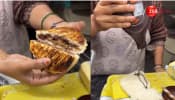Washington: A groundbreaking 3-D printed device, developed at the University of Michigan, saved a 20-month-old boy who was suffering from life-threatening tracheobronchomalacia, by restoring his breathing.
Every day April and Bryan Gionfriddo watched helplessly as their son, Kaiba, stopped breathing due to his collapsed bronchus blocking the crucial flow of air to his lungs.
The mom revealed that doctors have even told her that Kaiba had a good chance of not leaving the hospital alive.
But they found new hope at the University of Michigan, where a new, bioresorbable device that could help Kaiba was under development.
Kaiba`s doctors contacted Glenn Green, M.D., associate professor of paediatric otolaryngology at the University of Michigan.
Green and his colleague, Scott Hollister, Ph.D., professor of biomedical engineering and mechanical engineering and associate professor of surgery at U-M, went right into action, obtaining emergency clearance from the Food and Drug Administration to create and implant a tracheal splint for Kaiba made from a biopolymer called polycaprolactone.
On February 9, 2012, the specially-designed splint was placed in Kaiba at C.S. Mott Children`s Hospital. The splint was sewn around Kaiba`s airway to expand the bronchus and give it a skeleton to aid proper growth. Over about three years, the splint will be reabsorbed by the body.
Green said as soon as the splint was put in, the lungs started going up and down for the first time and they came to know the child was going to be OK.
Green and Hollister were able to make the custom-designed, custom-fabricated device using high-resolution imaging and computer-aided design. The device was created directly from a CT scan of Kaiba`s trachea/ bronchus, integrating an image-based computer model with laser-based 3D printing to produce the splint.
Kaiba was off ventilator support 21 days after the procedure, and has not had breathing trouble since then.
"He has not had another episode of turning blue. We are so thankful that something could be done for him. It means the world to us," the boy`s mom said.
The case is featured in the New England Journal of Medicine.
ANI















